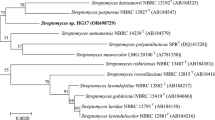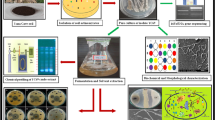Abstract
The present study aimed to assess and monitor the therapeutic potential of antimicrobial metabolites from marine sponge–associated bacteria collected from the southeast coast of India against multidrug-resistant clinical bacterial isolates. Five sponge samples were collected and the metabolite-producing bacteria were screened from the Gulf of Mannar, India, and their antibacterial potential was studied against drug-resistant clinical bacterial isolates obtained from the hospitals. The two metabolite-producing bacteria (IS1 and IS2) were characterized by standard microbiology protocols and 16S rRNA sequencing. The antibacterial metabolites were characterized by liquid chromatography mass spectrometry (LCMS) analysis. The study suggested that marine sponges such as Spheciospongia spp., Haliclona spp., Mycale spp., Tedania spp., and SS-01 were associated with 30 ± 2, 26 ± 2, 23 ± 3, 21 ± 2, and 20 ± 2% of antibacterial metabolite-producing bacteria, respectively. The LCMS analysis of metabolites extracted from IS1 (4,6-dimethyl-2-pyrimidinamine; 4,5-dimethyl-2-propylsilyl-1H-imidazole) and IS2 (caproyl amide, 2-imidazoline) associated with Spheciospongia spp. exhibited significant antibacterial properties against drug-resistant bacteria. IS1 showed antimicrobial potential against the clinical isolates of Proteus spp., and IS2 showed antibacterial potential against isolates of both Proteus mirabilis and Salmonella typhi. IS1 and IS2 were identified by 16S rRNA sequencing and designated as Klebsiella spp. DSCE-bt01 and Pseudomonas spp. DSCE-bt02, respectively. The current study concluded that the assessment and monitoring of novel isolates from sponge-associated bacteria from marine coastal areas probably offer latest breakthrough in curtailing the global antimicrobial resistance and the study of such ecosystems adds value addition to the searching of novel bioactive compounds from terrestrial ecosystems.




Similar content being viewed by others
References
Almeida, E. L., Margassery, L. M., Kennedy, J., & Dobson, A. D. W. (2018). Draft genome sequence of the antimycin-producing bacterium Streptomyces sp. strain SM8, isolated from the marine sponge Haliclona simulans. Genome Announcement., 6(4), e01535–e01517. https://doi.org/10.1128/genomeA.01535-17.
Anand, T. P., Bhat, A. W., & Shouche, Y. S. (2006). Antimicrobial activity of marine bacteria associated with sponges from the waters off the coast of South East India. Microbiological Research, 161, 252–262.
Asagabaldan, M. A., Ayuningrum, D., & Kristiana, R. (2017). Identification and antibacterial activity of bacteria isolated from marine sponge Haliclona (Reniera) sp. against multi-drug resistant human pathogen. IOP Conference Series: Earth and Environmental Science, 55, 012019. https://doi.org/10.1088/17551315/55/1/012019.
Bhatnagar, I., & Kim, S. K. (2010). Immense essence of excellence: marine microbial bioactive compounds. Marine Drugs, 8, 2673–2701.
Blunt, J. W., Copp, B. R., Munro, M. H., Northcote, P. T., & Prinsep, M. R. (2003). Marine natural products. Natural Product Reports, 20(1), 1–48.
Chia, L., & Crum-Cianflone, N. F. (2018). Emergence of multi-drug resistant organisms (MDROs) causing Fournier’s gangrene. Journal of Infection, 76, 38–43.
Christensen, A., & Martin, G. D. A. (2017). Identification and bioactive potential of marine microorganisms from selected Florida coastal areas. Microbiology Open, 6. https://doi.org/10.1002/mbo3.448.
Clinical Laboratory Standard Institute. (2017). Performance standards for antimicrobial susceptibility testing. Twentieth informational supplement, Clinical and Laboratory Standards Institute Doc. M100eS20, 2010.
Correa-Martínez, C. L., Idelevich, E. A., Sparbier, K., Kostrzewa, M., & Becker, K. (2019). Rapid detection of extended-spectrum β-lactamases (ESBL) and ampc β-lactamases in enterobacterales: development of a screening panel using the maldi-tof ms-based direct-on-target microdroplet growth assay. Frontiers in Microbiology, 10, 13. https://doi.org/10.3389/fmicb.2019.00013.
Dhinakaran, D. I., Manohari, V., Atchya, B., Tamilselvi, K., & Lipton, A. P. (2012). Antifungal and cytotoxic activities of some marine sponges collected from the south east coast of India. Journal of Applied Pharmaceutical Science, 2, 52–55.
Eltamany, E. E., Abdelmohsen, U. R., & Ibrahim, A. K. (2014). New antibacterial xanthone from the marine sponge-derived Micrococcus sp. EG45. Bioorganic & Medicinal Chemistry Letters, 24(21), 4939–4942.
Funke, G., Monnet, D., deBernardis, C., Graevenitz, A. V., & Freney, J. (1998). Evaluation of the VITEK 2 system for rapid identification of medically relevant gram-negative rods. Journal of Clinical Microbiology, 36, 1948–1952.
Ghasemi, B., Sanjarani, G., Sanjarani, Z., & Majidiani, H. (2015). Evaluation of anti-bacterial effects of some novel thiazole and imidazole derivatives against some pathogenic bacteria. Iranian Journal of Microbiology, 7, 281–286.
Huang, X., Kong, F., Zhou, S., Huang, D., Zheng, J., & Zhu, W. (2019). Streptomyces tirandamycinicus sp. nov., a novel marine sponge-derived actinobacterium with antibacterial potential against streptococcus agalactiae. Frontiers in Microbiology, 10, 482. https://doi.org/10.3389/fmicb.2019.00482 eCollection 2019.
Krieg, N. R., Ludwig, W., & Whitman, W. B. (2010). Bergey’s manual of systematic bacteriology. New York: Springer.
Marty, M. J., Vicente, J., Oyler, B. L., Place, A., & Hill, R. T. (2017). Sponge symbioses between Xestospongia deweerdtae and Plakortis spp. are not motivated by shared chemical defence against predators. Plos One, 12(4), e0174816. https://doi.org/10.1371/journal.pone.0174816.
Means, E. G., Hanami, H. F., Ridgway, H. F., & Olson, B. H. (1981). Evaluating mediums and plating techniques for enumerating bacteria in water distribution systems. Journal of the American Water Works Association, 73, 585–590.
Mehbub, M. F., Lei, J., Franco, C., & Zhang, W. (2014). Marine sponge derived natural products between 2001 and 2010: trends and opportunities for discovery of bioactives. Marine Drug, 12, 4539–4557.
Metabole, R. M., Joaquim van Zyle, L., Parker-Nance, S., Davies-Coleman, M. T., & Trindade, M. (2017). Antibacterial activities of bacteria isolated from the marine sponges Isodictya compressa and Higginsia bidentifera collected from Algoa Bay, South Africa. Marine Drugs, 15, 47.
Miller, J. M., Krisher, K., & Holmes, H. T. (2007). General principles of specimen collection and handling. Manual of Clinical Microbiology, 9, 52–85.
Milton, M. E., Draughn, G. L., & Feldmann, E. A. (2017). Inhibition and dispersion of biofilms: targeting bacterial response regulators to resensitize multidrug resistant bacteria to antibiotics. The FASEB Journal, 31, 939.
Moghadam, M. E., Divsalar, A., & Zare, M. S. (2017). Anticancer, antibacterial and antifungal activity of new ni (ii) and cu (ii) complexes of imidazole-phenanthroline derivatives. Nucleosides, Nucleotides & Nucleic Acids, 36, 667–675.
Muthiyan, R., Nambikkairaj, B., & Mahanta, N. (2017). Antiproliferative and proapoptotic activities of marine sponge Hyrtios erectus extract on breast carcinoma cell line (MCF-7). Pharmacognosy Magazine, 13, S41–S47.
Offret, C., Desriac, F., & Le Chevalier, P. (2016). Spotlight on antimicrobial metabolites from the marine bacteria Pseudoalteromonas: chemodiversity and ecological significance. Marine Drugs, 14, 129.
Ong, J. F. M., Goh, H. C., Lim, S. C., Pang, L. M., Chin, J. S. F., Tan, K. S., Liang, Z. X., Yang, L., Glukhov, E., Gerwick, W. H., & Tan, L. T. (2019). Integrated genomic and metabolomic approach to the discovery of potential anti-quorum sensing natural products from microbes associated with marine samples from Singapore. Marine Drugs, 17. https://doi.org/10.3390/md17010072.
Page, R. (1996). TREEVIEW: An application to display phylogenetic trees on personal computers. Computer Applications in the Biosciences: CABIOS, 12(4), 357–358.
Ramkumar, B., Venu, S., Ramakritinan, C. M., & Jayasingh, M. (2012). Distribution and abundance of marine sponges (Porifera) of two unique study areas of south Andaman, India. Asian Journal of Marine Sciences, 1, 17–23.
Richter, L., Du Plessis, E. M., Duvenage, S., & Korsten, L. (2019). Occurrence, identification, and antimicrobial resistance profiles of extended-spectrum and ampc β-lactamase-producing enterobacteriaceae from fresh vegetables retailed in Gauteng province, South Africa. Food Borne Pathogens and Disease, 16, 421–427. https://doi.org/10.1089/fpd.2018.2558.
Saitou, N., & Nei, M. (1987). The neighbor-joining method: A new method for reconstructing phylogenetic trees. Molecular Biology and Evolution, 4, 406–425.
Sanjeeva Reddy, C., Vani Devi, M., Sunitha, M., & Nagaraj, A. (2010). Synthesis and antimicrobial study of linked heterocyclics containing Pyrazole-pyrimidine-thiazolidin-4-one. Chemical and Pharmaceutical Bulletin (Tokyo), 58, 1622–1626.
Sivaleela, G. (2014). Marine sponges of Gulf of Mannar and Palk Bay. Zoological Survey of India, 114, 607–622.
Skariyachan, S., Rao, A. G., Patil, M. R., Saikia, B., Bharadwaj, V., & Rao, G. S. J. (2014). Antimicrobial potential of metabolites extracted from bacterial symbionts associated with marine sponges in coastal area of Gulf of Mannar Biosphere, India. Letters in Applied Microbiology, 58, 231–241.
World Health Organization (WHO). (2017). http://www.who.int/mediacentre/news/releases/2017/bacteria-antibiotics-needed/en/.
Worthington, R. J., & Melander, C. (2013). Combination approaches to combat multi-drug resistant bacteria. Trends in Biotechnology, 31, 177–184.
Ye, L., Santos-Gandelman, J. F., Hardoim, C. C., George, I., Cornelis, P., & Laport, M. S. (2015). Antibacterial activity and mutagenesis of sponge-associated Pseudomonas fluorescens H41. Antonie Van Leeuwenhoek, 108, 117–126. https://doi.org/10.1007/s10482-015-0469-4.
Zeng, Z., Zhao, J., Ke, C., & Wang, D. (2013). Antimicrobial activities of novel cultivable bacteria isolated from marine sponge Tedania anhelans. Chinese Journal of Oceanology and Limnology, 31, 581–590.
Zobell, C. E. (1937). The influence of solid surface upon the physiological activities of bacteria in seawater. Journal of Bacteriology, 33, 39–56.
Author information
Authors and Affiliations
Corresponding author
Ethics declarations
Conflict of interest
The authors declare that they have no conflict of interest.
Research involving human participants and/or animals
Not applicable
Informed consent
Not applicable
Additional information
Publisher’s note
Springer Nature remains neutral with regard to jurisdictional claims in published maps and institutional affiliations.
Electronic supplementary material
ESM 1
(DOC 549 kb)
Rights and permissions
About this article
Cite this article
Skariyachan, S., Challapilli, S.B., Packirisamy, S. et al. Monitoring and assessment of the therapeutic impact of metabolites extracted from sponge-associated bacteria screened from Gulf of Mannar, southeast coast of India. Environ Monit Assess 192, 241 (2020). https://doi.org/10.1007/s10661-020-8201-x
Received:
Accepted:
Published:
DOI: https://doi.org/10.1007/s10661-020-8201-x




